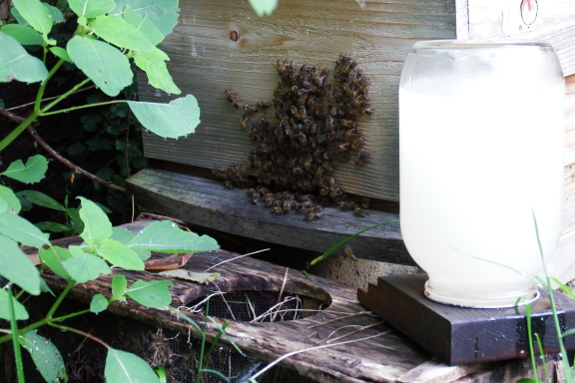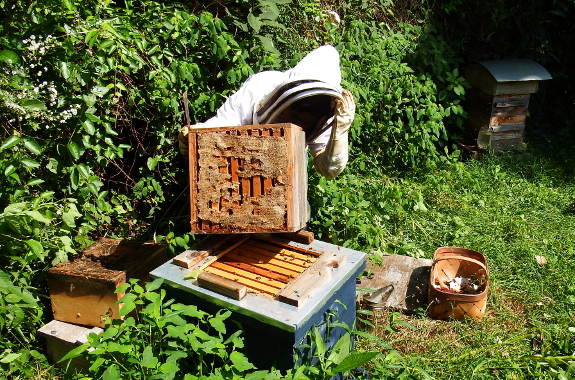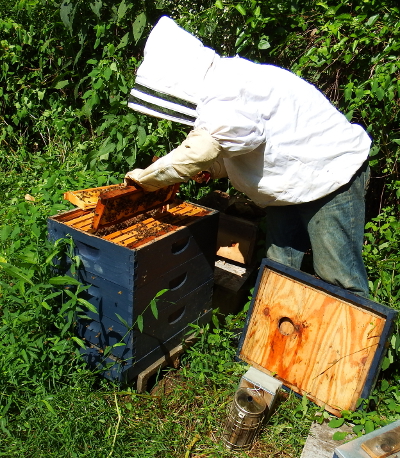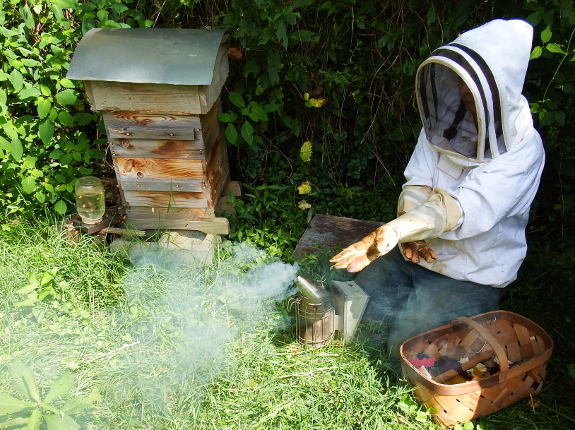
Bearding bees

I'd been putting off adding a third box to our daughter hive, hoping that the mother hive would be done moving into the Langstroth boxes so I could begin converting
the daughter hive with the same hardware. But when I dropped by the
daughter hive Thursday morning to refill their feeder, the photo above
shows what I saw. Unless the weather is very hot, bearding is a sign
that the bees in your hive need more room. Time to get my act together
and add another box!

 After
waiting until the sun was blazing and the foragers were out in the
field, Mark and I stopped by the mother hive first. The one Warre box in
this hive was very heavy, full of capped honey, and at first I thought
I'd be able to call the conversion a success.
After
waiting until the sun was blazing and the foragers were out in the
field, Mark and I stopped by the mother hive first. The one Warre box in
this hive was very heavy, full of capped honey, and at first I thought
I'd be able to call the conversion a success.
But when I delved into
the Langstroth box underneath, I found only honey and pollen, no brood.
And when I peered more carefully up under that single Warre box, I saw
some capped brood, signaling that the queen is still working up in the
attic. So I put the hive back together as-is and headed over to the
Warre hive with plan B in mind.

Although we could have made another Langstroth-to-Warre converter, I opted to instead go the simple route and just nadir
another Warre box under the daughter hive. The bees will have space to
keep expanding, and we'll wait until next year to convert them over to a
Langstroth hive.
On a different note, I
was heartened by how hard both colonies of bees are working this year.
The daughter hive is on the dole (sugar water), which seems to have
helped them bulk up well (although they still have a lot fewer foragers
than the mother hive). And the mother hive is doing well also, although
they appear to have eaten some of their honey since I last checked. If
nothing else, I hope both hives will be ready to go into winter without
any (or much) additional fall feeding.
Want more in-depth information? Browse through our books.
Or explore more posts by date or by subject.
About us: Anna Hess and Mark Hamilton spent over a decade living self-sufficiently in the mountains of Virginia before moving north to start over from scratch in the foothills of Ohio. They've experimented with permaculture, no-till gardening, trailersteading, home-based microbusinesses and much more, writing about their adventures in both blogs and books.
Want to be notified when new comments are posted on this page? Click on the RSS button after you add a comment to subscribe to the comment feed, or simply check the box beside "email replies to me" while writing your comment.

I have a friend at work who raises chickens and sells the eggs. The yolks are the same quality golden yellow that you aspire for. My mother's boyfriend poo-poohed me and my fresh golden yolk eggs and said the eggs in the store are just as healthy and that the golden yellow comes from sunflowers.
I just wanted to share with you and let you know that I am learning so much from you.